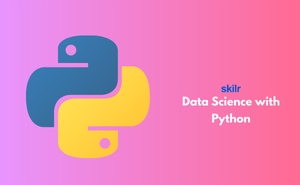👇 CELEBRATE CLOUD SECURITY DAY 👇
00
HOURS
00
MINUTES
00
SECONDS

About Data Science with Python
Learners receive a thorough grasp of data analytics tools & methodologies with this Data Science with Python training. You may learn about data analysis, visualization, NumPy, SciPy, web scraping, and natural language processing by getting started with Python.
The fundamentals of the Python programming environment, including core python programming methods like lambdas, reading and manipulating CSV files, and the Numpy library, will be covered in this course. The popular Python pandas data science library will be used to educate on how to manipulate and clean data, explain the abstraction of Series and DataFrame as the key data structures for data analysis, and provide lessons on how to efficiently use tools like groupby, merge, and pivot tables.
Why is Data Science with Python important?
Python's data science libraries are excellent for dealing with data science applications. Because of its simplicity and ease of use, Python is one of the most popular programming languages in the scientific and research sectors. People without technical backgrounds may easily learn how to use it because of this.
Who should take the Data Science with Python Exam?
Data Science with Python Certification Course Outline
Industry-endorsed certificates to strengthen your career profile.
Start learning immediately with digital materials, no delays.
Practice until you’re fully confident, at no additional charge.
Study anytime, anywhere, on laptop, tablet, or smartphone.
Courses and practice exams developed by qualified professionals.
Support available round the clock whenever you need help.
Easy-to-follow content with practice exams and assessments.
Join a global community of professionals advancing their skills.
Yes, certifications from reputable platforms or institutions are widely recognized across industries and geographic regions, especially if aligned with industry best practices and standards.
The passing score generally falls between 65% and 75%, depending on the certifying organization’s standards. Candidates must achieve this score to earn the certificate.
While certification alone does not guarantee employment, it strengthens a candidate’s portfolio and demonstrates verified competency in Python for data science, which is valuable for job applications and interviews.
Yes, candidates are expected to write and interpret Python code, particularly for tasks involving data manipulation, visualization, or implementing machine learning models.
Yes, most certification exams have a time limit ranging from 90 to 150 minutes, depending on the exam provider. This time includes both theoretical and practical components.
The exam typically consists of multiple-choice questions, coding exercises, and short case-based problems that test practical knowledge and application of data science concepts using Python.
The exam includes questions on Python syntax, Pandas, NumPy, data cleaning, exploratory data analysis, data visualization, statistical methods, machine learning with Scikit-learn, and model evaluation.
Yes, most certification bodies allow retakes, although some may require a waiting period or charge a nominal retake fee. Specific policies depend on the exam provider.
The exam is designed to assess a candidate’s ability to apply Python programming to perform data analysis, visualization, statistical modeling, and machine learning in real-world data science scenarios.
The exam is open to students, professionals, and aspiring data scientists who have foundational knowledge of Python and basic understanding of data analysis or statistics.